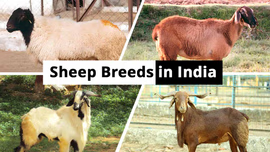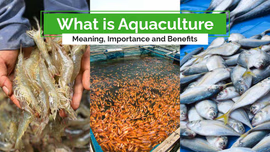What is Animal Husbandry: Its Importance, Types and Benefits

Animal husbandry is an important branch of agriculture that involves raising, breeding, and management of animals. It is a broad term that covers a variety of practices, from raising livestock in small farms to commercial animal farming. It fulfils various needs of the human population, including milk, meat and wool. Animal husbandry involves practices that not only benefit farmers financially but also contribute to India's food security and economy. This blog explores animal husbandry from the Indian context.
Table of Contents
- Overview of the Livestock Census
- What is Animal Husbandry?
- What are the Main Types of Animal Husbandry?
- Government Initiatives for Animal Husbandry in India
- What are the Advantages of Animal Husbandry for Indian Farmers?
- What Good Animal Husbandry Practices Benefit Farmers?
- What is the Difference between Animal Husbandry & Livestock?
Overview of the Livestock Census
As per the Department of Animal Husbandry and Dairying, the Indian livestock sector has grown at a CAGR of 12.99% between 2014-15 and 2022-23. The contribution of the livestock sector in total Gross Value Added (GVA) was 5.50% in 2022-23. India ranks first in milk production, second in egg production, and fifth in meat production globally.
The 20th Livestock Census report was released in 2019 to benefit policy makers, entrepreneurs, entrepreneurs, traders, agriculturists, and the general population.
- As per this report, the total Livestock population is 535.78 million. It showed a 4.6% increase compared to the Livestock Census 2012.
- The bovine population has increased by 1% to reach 302.79 million.
- In 2019, the total number of cattle was noted to be 192.49 million, while the total number of buffaloes was 109.85 million.
- The sheep population in India is 74.26 million, while the total goat population is 148.88 million.
- The report shows that the total population of pigs is 9.06 million, and the total poultry population is 851.81 million.
The 21st Livestock Census was launched on 25th October 2024 to update data on 219 indigenous breeds of 16 species.
What is Animal Husbandry?
Animal husbandry is scientific management that involves raising and taking care of animals, birds, and fish in a way that promotes the welfare of animals and ensures the quality of their products, like milk, meat, fibre, and other products. It is a broad term known to cover various practices, including breeding, feeding, weeding, and heeding of animals. But what exactly are these practices? Let us understand briefly:
- Breeding: It is a practice of producing high milk-yielding, egg-yielding, or meat-yielding breeds of animals.
- Feeding: It deals with feeding animals. It involves selecting the right feed type, method, and animal feed time.
- Weeding: It is the practice of eliminating uneconomical livestock, birds, or fish.
- Heeding: It deals with the proper care and management of livestock.
What are the Main Types of Animal Husbandry?
The types of animal husbandry largely depend on the species of animals being raised. The leading animal husbandry examples are poultry farming, dairy farming, fish farming, and beekeeping.
Poultry Farming
Poultry Farming focuses on breeding and raising poultry birds such as chickens, turkeys, ducks, and geese. This branch of animal husbandry is primarily geared towards chicken and egg production. During 2022-23, the total egg production was 138.38 billion. Raising poultry requires nutrient-rich feed, which is rich in Vitamin A and Vitamin K. Besides, proper cleaning, sanitation, and disinfectant spraying are necessary to prevent diseases in poultry fowl.
Poultry farming involves a variety of chicken breeds in India. Besides, poultry fowls can be crossbred to improve the variety of breeds. For example, the indigenous Aseel can be crossbred with foreign Leghorn to develop new varieties. With the increased demand for poultry products, the scope of the Poultry Farming Business in India has increased.
Cattle Farming
Cattle Farming is the practice of breeding and rearing cattle for dairy and draught labour work. Two types of cattle are bred primarily in India: cows and buffalo. Some of the top cow breeds in India are Tharparkar, Sahiwal, Red Sindhi, and Gir. Also, the top Indian buffalo breeds include Murrah, Jaffrabadi, Surti, and Bhadawari.
Dairy animals are female cattle and are primarily used for milk. Thus, they are also called milch animals. On the other hand, draught animals are domesticated for agricultural work like tilling and irrigating. The cattle are crossbred to produce the improved breeds of cattle that are high milk-yielding and disease-resistant. For instance, exotic or foreign cattle breeds such as Jersey and Brown Swiss are known for longer lactation periods. Thus, these cattle breeds are crossbred with local breeds like Red Sindhi and Sahiwal, which have excellent disease-resistant qualities.
Beekeeping
Beekeeping is also among the top animal husbandry types. It is the practice of raising and managing bee colonies. It requires low investment; thus, farmers undertake honey bee farming, or Apiculture, to generate additional income. In 2022, the National Bee Board registered 19.34 lakh honeybee colonies and 12,699 beekeepers.
Beekeeping is primarily used to produce honey and other bee-related products like beeswax, royal jelly, and propolis. The value, quality, and taste of honey are the outcome of the quantity of pasturage and the availability of flower and nectar varieties. In India, many varieties of bees are used for the commercial production of honey. Some of them are Indian Bee (Apis cerena indica), Rock Bee (A. dorsata), and Little Bee (A. florae).
Fish Farming
Fish farming or Aquaculture is concerned with breeding and rearing fish in controlled environments such as ponds or tanks. India has around 8% share in the global fish production, making it the second-largest fish-producing country. The production of fish in India emphasizes true fish and shellfish, such as molluscs and prawns.
Fish can be obtained in two ways: capture fishing and culture fishing. The former involves catching the fish directly from natural resources like the sea or river, whereas the latter involves rearing fish in controlled environments like ponds, tanks, or cages. In 2023-24, the total fish production was 184.02 lakh tons.
The fisheries sector can further be divided into Marine and Inland Fisheries. Popular marine fish varieties include Mackerel, Sardines, Tuna, Pomphret, and Bombay duck. On the other hand, popular inland fish are Catla, Silver Carp, Rohu, Grass Carp, and Common Carp. Fish farming business is a profitable venture for Indian farmers because of the increasing demand for fish and related products.
Government Initiatives for Animal Husbandry in India
The Department of Animal Husbandry and Dairying is one of the Departments under the Ministry of Fisheries, Animal Husbandry and Dairying. This department’s objective is to work towards empowering the livestock sector through skilled youth, farmers, and entrepreneurs’ livestock management. It is also responsible for issues relevant to the Delhi Milk Scheme (DMS) and the National Dairy Development Board (NDDB). It advises state governments/union territories on the generation of policies and programmes in the area of animal husbandry and dairy development. The Indian government has started several animal husbandry and dairying schemes, including:
- Rashtriya Gokul Mission
- National Programme for Dairy Development (NPDD)
- National Livestock Mission (NLM)
- Animal Husbandry Infrastructure Development Fund (AHIDF)
- Livestock Health and Disease Control Programme (LHDCP)
What are the Advantages of Animal Husbandry for Indian Farmers?
Why is animal husbandry essential? Here are some of the critical advantages of animal husbandry in India:
- Animal husbandry provides livelihoods and employment opportunities to millions of people residing in rural areas.
- India is the largest producer of milk globally and provides a continuous supply of milk for consumption, making it a crucial source of high-quality protein.
- Livestock, particularly drought-resistant breeds like the Kankrej and Deoni cattle, play a critical role in ensuring stable income, increased productivity, and reduced losses in drought-prone regions.
- Animal husbandry efforts help conserve and maintain the diverse livestock breeds, ensuring their survival for future generations.
- Draught animals are an important provider of non-human labour because they are used for tilling, irrigating, transporting, etc.
What Good Animal Husbandry Practices Benefit Farmers?
- Safe Animal Feed: The microbial contamination, antibiotic residues, and adulteration of animal feed are spreading quite vigorously. Therefore, providing animal feed with better nutritional content leads to the welfare of animals, with direct animal health benefits that ultimately benefit the farmers or consumers.
- Animal Welfare: Animals should be reared in humane conditions. They should not suffer from thirst, hunger, malnutrition, discomfort, pain, stress, fear, injury, or disease. Proper amount of food, shelter, etc., should be provided to them for overall improvement in health and productivity.
- Disease Prevention: In order to prevent any outbreak of diseases, vaccination programs and regular health check-ups are mandatory to ensure a healthy livestock population.
- Proper Handling & Transportation: It is important to handle animals gently and ensure proper methods for their transportation to reduce stress and injury.
- Clean Animal Living Conditions: Maintaining clean, well-ventilated, sound-controlled housing with appropriate temperature and pest control for animals helps prevent diseases and leads to healthy animals.
- Record Keeping: Detailed records of animal health, feed, and production help monitor and improve farm management practices.
What is the Difference between Animal Husbandry & Livestock?
Having understood the concept of animal husbandry, let us know the difference between animal husbandry and livestock. Livestock basically means farm animals raised in an agricultural setting for labour or products. On the contrary, animal husbandry means raising, breeding, and managing animal livestock. Animal husbandry is much broader in scope and involves raising and breeding animals, birds, fish, or insects. On the other hand, livestock farming usually only includes raising animals to obtain a variety of commodities, including milk, wool, eggs, and meat.
Animal husbandry makes a valuable contribution to the national economy. Even though this sector has huge potential, it is far from realizing its full potential. It faces a wide range of issues like low feed conversion efficiency, nitrogen utilization efficiency, product quality, and high methane emissions. A multifaceted approach is required to improve animal husbandry in India with a focus on the adoption of modern technologies, enhanced health management, improved nutrition, and better breeding practices.
Frequently Asked Questions On What is Animal Husbandry: Its Importance, Types and Benefits
1. What is animal husbandry?
Animal husbandry is an important branch of agriculture that involves breeding, feeding, raising, and heeding of animal livestock.
2. How does animal husbandry benefit farmers?
Animal husbandry provides additional income to the farmers in the form of its by-products like meat, manure, etc.
3. What are the main elements of animal husbandry?
The main elements of animal husbandry are breeding, feeding, weeding, and heeding.
4. What are some examples of animal husbandry?
Some examples of animal husbandry include cattle farming, dairy farming, poultry farming, beekeeping, and fish farming.
5. What are the advantages of animal husbandry?
The main advantages of animal husbandry include ensuring proper nutrition and employment opportunities for rural population.


Related Blogs












